UM VOTO PARA A (DES)INFORMAÇÃO
DOI:
https://doi.org/10.23925/2316-3267.2022v11i3p173-195Abstract
In an election year like the current one (2022), in a scenario as polarized as the one we are experiencing, causing controversy, muting opponents and spreading fear in the population through fake news are very important political weapons. With that in mind, this article aims to analyze how the use of a source can favor the seduction for a fallacious speech. To do so, we selected the initial excerpt of an interview given by congressman Otoni de Paula to the TVJCO channel about fraud in electronic voting machines in Brazil (May 20, 2022). We resorted to the theoretical-methodological framework of Discourse Analysis (AD), proposed by Charaudeau (2013) and the Journalism disinformation ecosystem, proposed by Wardle and Derakhshan (2017a and 2017b). Therefore, we believe that our study can contribute to elucidate how the dimension of language and discourse is political and strengthened by the interests of certain social groups.
Keywords: Policy. Fake News. Source. Electronic ballot box.
References
AFONSO, Natalia. É falso que peritos da PF demonstraram que urnas eletrônicas não são confiáveis. Lupa, 2022. Disponível em: É falso que peritos da PF demonstraram que urnas eletrônicas não são confiáveis (uol.com.br). Acesso em: 05 jun. 2022.
BARROS, Diana Luz Pessoa de. Algumas reflexões sobre o papel dos estudos linguísticos e discursivos no ensino-aprendizagem na escola. Estudos semióticos. São Paulo: USP, v. 15, n. 2, p. 1-14, 2019.
CORNU, Daniel. Da deontologia do jornalismo à ética da informação. Conferência proferida na Faculdade de Letras da Universidade de Coimbra. Imprensa da Universidade de Coimbra. Portugal, jan. 2015. Disponível em: https://digitalis-dsp.uc.pt/bitstream/10316.2/36646/1/Da%20deontologia%20do%20jornalismo%20%C3%A0%20%C3%A9tica%20da%20informa%C3%A7%C3%A3o.pdf. Acesso em: 30 jul. 2020.
CHARAUDEAU, Patrick. Discurso das mídias. São Paulo: Contexto, 2013.
FERRARI, Pollyana; BOARINI, Margareth. A desinformação é o parasita do século XXI. Organicom, ano 17, n. 34, setembro/dezembro 2020. Disponível em: Vista do A desinformação é o parasita do século XXI (usp.br). Acesso em: 05 jun. 2022.
________________. Como sair das bolhas. São Paulo: Educ / Fortaleza: Armazém de Cultura, 2018.
GENESINI, Silvio. A pós-verdade é uma notícia falsa. Revista USP, n. 116, 2018, p. 45-58. Disponível em: https://www.revistas.usp.br/revusp/article/view/146577/140223. Acesso em: 29 jul. 2020.
KARNAL, Leandro. A detração: breve ensaio sobre o maldizer. São Leopoldo:Unisinos, 2016.
MELLO, Patrícia Campos. A máquina do ódio: notas de uma repórter sobre fake news e violência digital. São Paulo: Companhia das letras, 2020.
SANTAELLA, Lucia. A pós-verdade é verdadeira ou falsa? Barueri: Estação das Letras e Cores, 2018.
______. A semiótica das fake news. Verbum, São Paulo: PUC-SP, v. 9, n. 2, p. 9-25, set. 2020.
SCOTT, John. Social Network Analysis. California, EUA: Sage Publications, 2012.
WARDLE, C.; DERAKHSHAN, H. Information disorder: toward an interdisciplinary framework for research and policy making. Council of Europe, Out., 2017a. Disponível em: https://rm.coe.int/information-disorder-toward-an-interdisciplinary-framework-for- researc/168076277c. Acesso em: 05 jun. 2022.
______. How did the news go “fake”? When the media went social. 2017b. Disponível em: https://www.theguardian.com/commentisfree/2017/nov/10/fake-news- social-media-current-affairs-approval. Acesso em: 05 jun. 2022.
Downloads
Published
Versions
- 2023-02-09 (2)
- 2022-10-31 (1)


